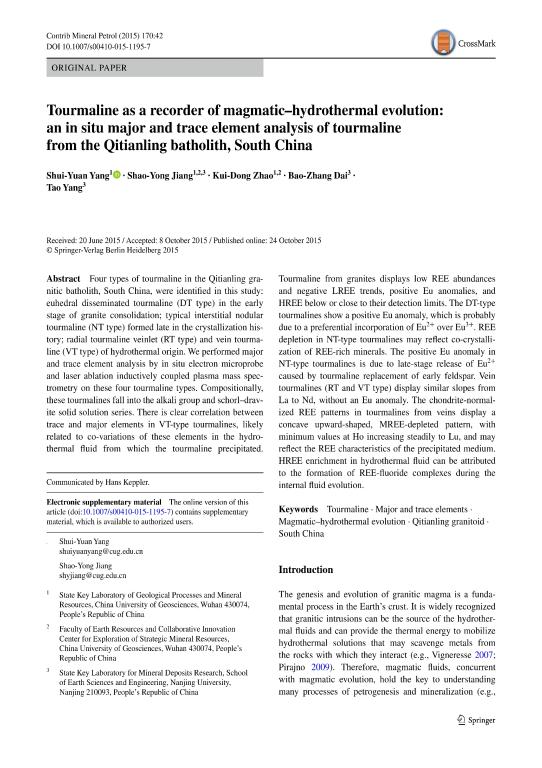

Shui‑Yuan Yang1, Tourmaline as a recorder of magmatic–hydrothermal evolution: an in situ major and trace element analysis of tourmaline from the Qitianling batholith, South China
Four types of tourmaline in the Qitianling gra nitic batholith, South China, were identified in this study: euhedral disseminated tourmaline (DT type) in the early stage of granite consolidation; typical interstitial nodular tourmaline (NT type) formed late in the crystallization his tory; radial tourmaline veinlet (RT type) and vein tourma line (VT type) of hydrothermal origin. We performed major and trace element analysis by in situ electron microprobe and laser ablation inductively coupled plasma mass spec trometry on these four tourmaline types. Compositionally, these tourmalines fall into the alkali group and schorl–drav ite solid solution series. There is clear correlation between trace and major elements in VT-type tourmalines, likely
related to co-variations of these elements in the hydro thermal fluid from which the tourmaline precipitated.
Tourmaline from granites displays low REE abundances and negative LREE trends, positive Eu anomalies, and HREE below or close to their detection limits. The DT-type tourmalines show a positive Eu anomaly, which is probably due to a preferential incorporation of Eu2+ over Eu3+. REE depletion in NT-type tourmalines may reflect co-crystalli zation of REE-rich minerals. The positive Eu anomaly in NT-type tourmalines is due to late-stage release of Eu2+caused by tourmaline replacement of early feldspar. Vein tourmalines (RT and VT type) display similar slopes from La to Nd, without an Eu anomaly. The chondrite-normal ized REE patterns in tourmalines from veins display a concave upward-shaped, MREE-depleted pattern, with minimum values at Ho increasing steadily to Lu, and may reflect the REE characteristics of the precipitated medium. HREE enrichment in hydrothermal fluid can be attributed to the formation of REE-fluoride complexes during the internal fluid evolution.
